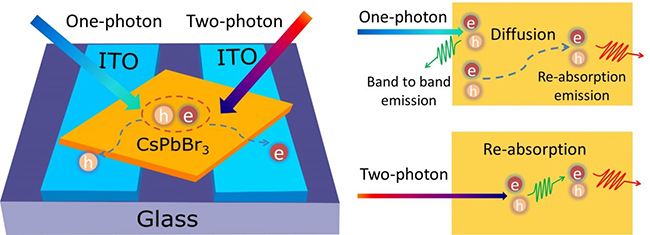Large absorption coefficient, low trap-state density, higher carrier mobility of the absorber and efficient charge carrier transfer in the device are the key parameters for photodetectors with high sensitivtiy and fast response time.
Despite exciting progress, the current all-inorganic perovskites (AIP) based photodetectors suffer from limited responsivity (R) and slow photoresponse. For example, AIP quantum dots or bulk thin films based photodetectors have low R (normally< 10 A/W), which is due to the low carrier mobility and the high trap-state density in these materials.
Perovskite single crystal, with low trap-state density, can be a good candidate for fabricating photodetectors with high R and fast response. However, the photodectors with centimeter-size preovskite crystal show poor performance (R< 10 A/W), due to the device size which is about three orders of magnitude larger than the charge carrier diffusion length (μm), and the charge carriers cannot be extracted efficiently.

Schematic of the CsPbBr3 MC-based photodetector
Scientists HAN Keli et al. from Dalian Institute of Chemical Physics (DICP) of the Chinese Academy of Sciences (CAS) used a solution growth method to prepare monocrystalline CsPbBr3 micro-crystals (MCs) with low trap-state density. This work has been published in Advanced Materials.
They studied the photophysical properties of the CsPbBr3 MCs by using time-resolved photoluminescence (PL) spectroscopy under one-photon excitation (OPE) and two-photon excitation (TPE). Under OPE, the PL exhibits double peak emission and the PL decay dynamics show a wavelength dependence. Compared to OPE, the TPE PL shows single emission peak with longer PL lifetime. Moreover, the TPE PL decay is wavelength independent which is different from OPE.
They concluded that the PL properties with OPE are caused by the fast carrier diffusion and the CsPbBr3 MCs exhibit high carrier mobility (over 100 cm2V-1S-1). The CsPbBr3 MCs based photodetector exhibits high R up to 6×104 A/W (D*~1013) with OPE, this is the highest value among AIP based photodetectors. The photodetectors also exhibit fast response time (~1 ms), which corresponds to a gain of ~105 and a gain-bandwidth up to 108 Hz.
Furthermore, the CsPbBr3 MCs based photodetectors show high R up to 6 A/W in near-infrared (NIR) region under TPE.
This work was supported by the key research project of National Natural Science Foundation. (Text and Image by BIN Yang)